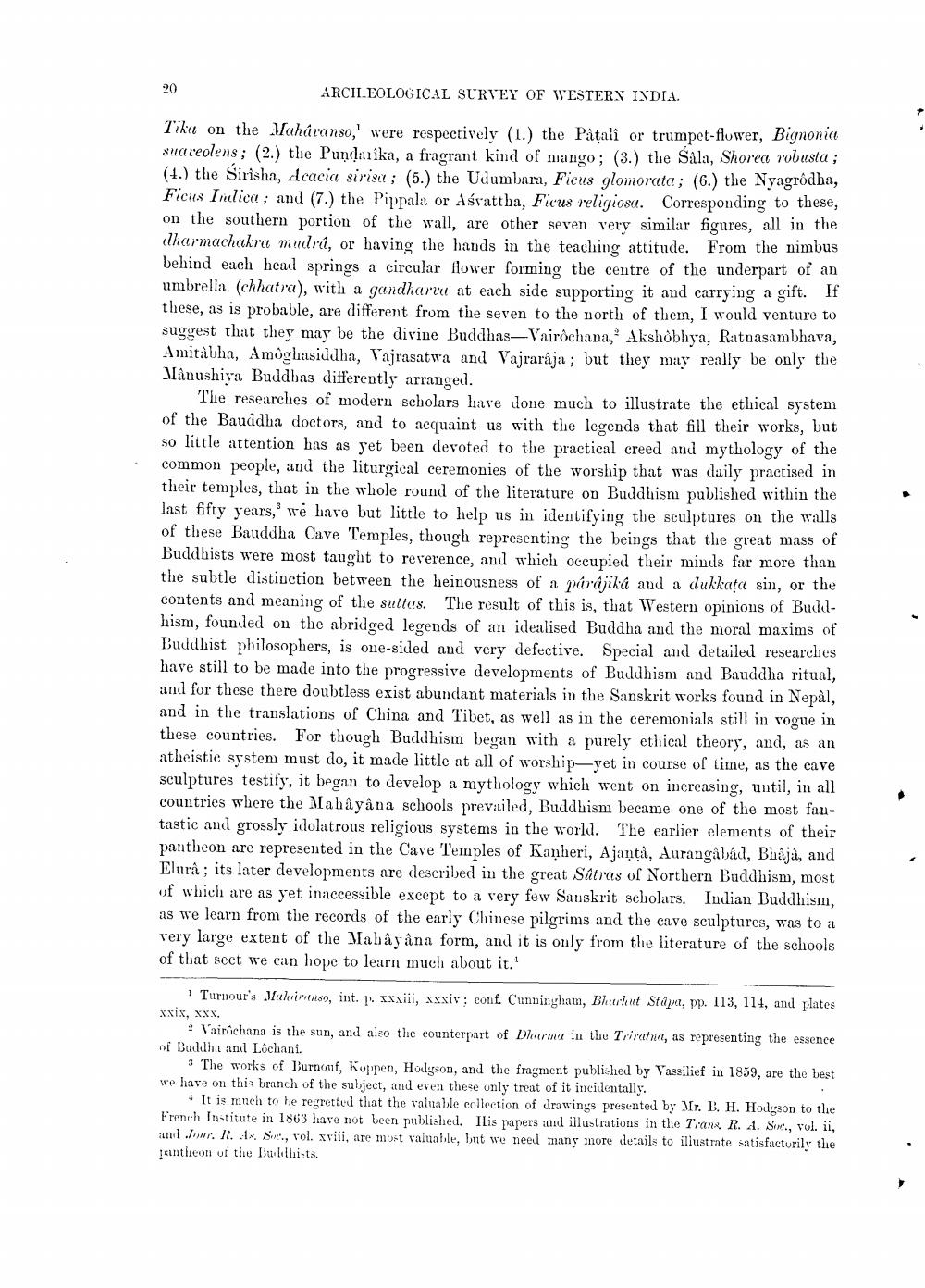________________
20
ARCIL.EOLOGICAL SURVEY OF WESTERN INDIA.
Tik on the Maharanao, were respectively (1.) the Patali or trumpet-flower, Bignonia suaveolens; (2) the Pundarika, a fragrant kind of mango; (3.) the Sala, Shorea robusta; (4.) the Sirisha, deacin sirisa; (5.) the Udumbara, Ficus glomorata; (6.) the Nyagrodha, Fiens Indien; and (7.) the Pippala or Asvattha, Ficus religiose. Corresponding to these, on the southern portion of the wall, are other seven very similar figures, all in the dharmachakra minded, or having the hands in the teaching attitude. From the nimbus behind each head springs a circular flower forming the centre of the underpart of an umbrella (chhatra), with a gandharu at each side supporting it and carrying a gift. If these, as is probable, are different from the seven to the north of them, I would venture to suggest that they may be the divine Buddhas-Vairochana," Akahobbya, Ratnasambhava, Amitabha, Amoghasiddha, Vajrasatwa and Vajrarája; but they may really be only the Manushiya Buddhas differently arranged.
3
The researches of modern scholars have done much to illustrate the ethical system of the Bauddha doctors, and to acquaint us with the legends that fill their works, but so little attention has as yet been devoted to the practical creed and mythology of the common people, and the liturgical ceremonies of the worship that was daily practised in their temples, that in the whole round of the literature on Buddhism published within the last fifty years, we have but little to help us in identifying the sculptures on the walls of these Bauddha Cave Temples, though representing the beings that the great mass of Buddhists were most taught to reverence, and which occupied their minds far more than the subtle distinction between the heinousness of a párájika and a dukkața sin, or the contents and meaning of the suttas. The result of this is, that Western opinions of Buddhism, founded on the abridged legends of an idealised Buddha and the moral maxims of Buddhist philosophers, is one-sided and very defective. Special and detailed researches have still to be made into the progressive developments of Buddhism and Bauddha ritual, and for these there doubtless exist abundant materials in the Sanskrit works found in Nepal, and in the translations of China and Tibet, as well as in the ceremonials still in vogue in these countries. For though Buddhism began with a purely ethical theory, and, as an atheistic system must do, it made little at all of worship-yet in course of time, as the cave sculptures testify, it began to develop a mythology which went on increasing, until, in all countries where the Mahâyâna schools prevailed, Buddhism became one of the most fautastic and grossly idolatrous religious systems in the world. The earlier elements of their pantheon are represented in the Cave Temples of Kanheri, Ajanta, Aurangabad, Bhâjà, and Elurâ; its later developments are described in the great Sutras of Northern Buddhism, most of which are as yet inaccessible except to a very few Sanskrit scholars. Indian Buddhism, as we learn from the records of the early Chinese pilgrims and the cave sculptures, was to a very large extent of the Mahâyâna form, and it is only from the literature of the schools of that sect we can hope to learn much about it.
Turnour's Mahiranso, int. p. xxxiii, xxxiv; conf. Cunningham, Bharhut Stapa, pp. 113, 114, and plates xxix, xxx.
Vairochana is the sun, and also the counterpart of Dharma in the Triratna, as representing the essence of Buddha and Lochani.
3 The works of Burnouf, Koppen, Hodgson, and the fragment published by Vassilief in 1859, are the best we have on this branch of the subject, and even these only treat of it incidentally.
It is much to be regretted that the valuable collection of drawings presented by Mr. B. H. Hodgson to the French Institute in 1863 have not been published. His papers and illustrations in the Trans. R. A. Soc., vol. ii, and Jour. R. As, Soc., vol. xviii, are most valuable, but we need many more details to illustrate satisfactorily the pantheon of the Buddhists.




